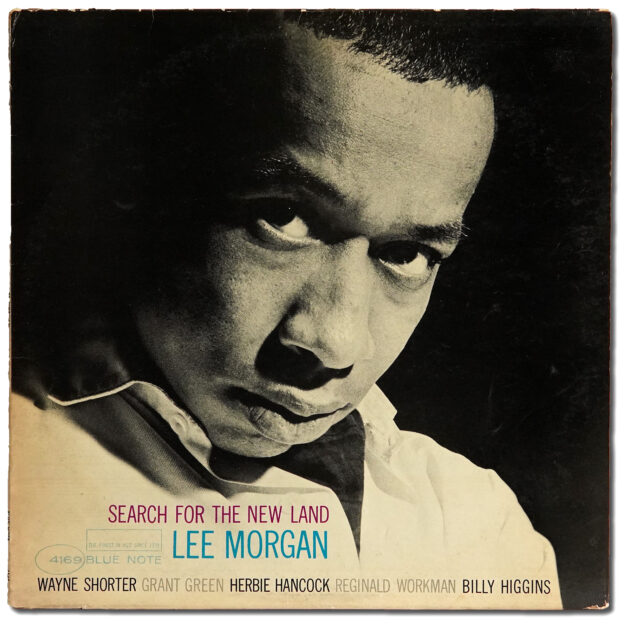- Second mono pressing circa 1966
- “NEW YORK USA” on both labels
- “VAN GELDER” stamped in dead wax
- “43 West 61st St., New York 23” address on jacket
Personnel:
- Lee Morgan, trumpet
- Wayne Shorter, tenor saxophone
- Grant Green, guitar
- Herbie Hancock, piano
- Reggie Workman, bass
- Billy Higgins, drums
Recorded February 15, 1964 at Van Gelder Studio, Englewood Cliffs, New Jersey
Originally released August 1966
| 1 | Search for the New Land | |
| 2 | The Joker | |
| 3 | Mr. Kenyatta | |
| 4 | Melancholee | |
| 5 | Morgan the Pirate |
Selection:
“Melancholee” (Morgan)
For Collectors
This record is especially hard to find with the Plastylite “P”, though it does exist. I have had good experiences with Liberty pressings though, so I’m not hung up on finding an original pressing of this album. The first copy I had, also a Liberty pressing, was cheap but it had a few loud pops and clicks, which prompted me to seek out this replacement, which I think was fairly graded VG+.
For Music Lovers
It’s difficult to discuss a Lee Morgan album without considering where and how it fits into the dramatic and tragic story of his life. At the age of 20, Morgan first recorded as a member of Art Blakey’s Jazz Messengers in October 1958 for the classic album Moanin’. His residency with Blakey would continue until the summer of 1961 when Morgan and fellow Philadelphian Bobby Timmons made the decision to retreat to their hometown for relief from the heroin-infested New York jazz scene. Morgan would only step in the studio once over the course of the next two years for producer Orrin Keepnews (Take Twelve, Jazzland 980), but would eventually make his official return to the New York recording scene in the fall of 1963 for a date with Hank Mobley (No Room for Squares, Blue Note 4149). After taking an uncharacteristic date with the progressive Grachan Moncur III the following month (Evolution, Blue Note 4153), Morgan recorded The Sidewinder in December 1963. The smash hit wouldn’t be released until the following summer, however. In the meantime, Morgan entered the studio again in February 1964 to record Search for the New Land, which would ultimately be shelved until 1966 – perhaps as a result of the tremendous commercial success of Sidewinder.
While Morgan and Shorter had been bandmates in The Jazz Messengers for years before Morgan’s hiatus, this would be the first of only a handful of occasions where the trumpeter would record with Herbie Hancock. (I was surprised to learn that this was only the second time that Shorter and Hancock had recorded together.) Billy Higgins returned from the Sidewinder date – which would prove to be the start of a lengthy partnership between he and Morgan – while Grant Green and Reggie Workman rounded out the sextet.
For all the Blue Note sessions Lee Morgan had led since he began recording for the label in 1956, this would only be the second where the entire program was penned by Morgan himself (The Sidewinder being the first). As such, Search for the New Land is a beautiful contemplation of the then looming and uncertain future of jazz. It is not a desperate exodus out of bop; it can be better likened to a child on the ocean’s shoreline standing knee-deep in the waves, hesitant to submerge themself in the water. Search thus pushes the boundaries of hard bop just enough to keep within the sub-genres inherent structure.
The album is consistent and cohesive. The dreamy, somber choruses of the title track are flanked by improvisational sections fashioning a minimal harmonic structure that compliments the modal leanings of Hancock and Shorter (this session would predict their uniting with Miles Davis as members of his “second great quintet” later that year). Hancock especially shines on the take with a crisp solo exemplifying his clear and acute thinking at the piano. “Mr. Kenyatta” bounces between moods in much the same way as the title track, swaying back and forth between feelings of angst and playfulness. And while The Penguin Guide to Jazz Recordings refers to the closing pair of songs as “more than makeweights” but “more off-the-peg” in comparison to the rest of the material, this ironically is my favorite sequence of the album. “Melancholee” is a gorgeously despondent composition that gives us a hard, honest look at the inner workings of Morgan, and the uplifting melody of “Morgan the Pirate” follows closely behind to conclude the album with an air of optimism.
One can’t help but wonder if the aforementioned session with Moncur had a profound impact on Morgan. Perhaps his experimentation at this time was actually a rebellion against the avant-garde manifesto, an attempt to push the boundaries of the institution of bop without succumbing to the full-blown chaos of free jazz. Either way, Search for the New Land is an expressive journey to the edges of an idiom, and it stands as an important work created at a pivotal crossroad in the evolution of the jazz art form.





